E-READINESS QUESTIONNAIRE FOR NORTH ... - Kunnat.net
E-READINESS QUESTIONNAIRE FOR NORTH ... - Kunnat.net
E-READINESS QUESTIONNAIRE FOR NORTH ... - Kunnat.net
Create successful ePaper yourself
Turn your PDF publications into a flip-book with our unique Google optimized e-Paper software.
7 Namibia<br />
7.1 Background and Government<br />
62<br />
The Republic of Namibia is a vast, sparsely populated country situated along the south<br />
Atlantic coast of Africa. It is the fi rst country in the world that has incorporated the<br />
protection of the environment into its constitution.<br />
South Africa occupied the German colony of South-West Africa during World War<br />
I and administered it as a mandate until after World War II, when it annexed the territory.<br />
In 1966 the Marxist South-West Africa People’s Organization (SWAPO) guerrilla<br />
group launched a war of independence for the area that became Namibia, but it was<br />
not until 1988 that South Africa agreed to end its administration in accordance with<br />
a UN peace plan for the entire region. Namibia has been governed by SWAPO since<br />
the country won independence in 1990. Hifi kepunye Pohamba was elected president<br />
in November 2004 in a landslide victory replacing Sam Nujoma who led the country<br />
during its fi rst 14 years of self rule. Pohamba was reelected in November 2009.<br />
In recent years supporters of land reform have become more vocal. The expropriation<br />
of white-owned farms began in 2005 and the government says it aims to resettle<br />
many thousands of landless citizens. Like its neighbours, Namibia’s wellbeing is being<br />
threatened by the HIV/Aids epidemic, which is estimated to affect 25% of Namibians<br />
80 .<br />
Geography and Demography<br />
Population: 2,108,665. Age structure:<br />
� 0-14 years: 35.9% (male 381,904/female 375,059)<br />
� 15-64 years: 60.2% (male 641,995/female 627,146)<br />
� 65 years and over: 3.9% (male 36,894/female 45,667) (2009 est.)<br />
Other population indicators include:<br />
� Urbanization: urban population: 37% of total population (2008)<br />
rate of urbanization: 2.9% annual rate of change (2005-10 est.)<br />
� Ethnic groups: about 50% of the population belong to the Ovambo ethnic group<br />
and 9% to the Kavangos ethnic group; other ethnic groups include Herero 7%,<br />
Damara 7%, Nama 5%, Caprivian 4%, Bushmen 3%, Baster 2%, Tswana 0.5%,<br />
white 6 %, other 6,5 %.<br />
� Religions: Christian 80% to 90% (Lutheran 50% at least), indigenous beliefs 10%<br />
to 20%<br />
� Languages: English 7% (offi cial), Afrikaans common language of most of the population<br />
and about 60% of the white population, German 32%, indigenous languages<br />
1% (includes Oshivambo, Herero, Nama)<br />
� Literacy: defi nition: age 15 and over can read and write<br />
total population: 85%<br />
male: 86.8%<br />
female: 83.5% (2001 census)<br />
� Administrative divisions: 13 regions; Caprivi, Erongo, Hardap, Karas, Khomas,<br />
Kunene, Ohangwena, Okavango, Omaheke, Omusati, Oshana, Oshikoto, Otjozondjupa<br />
81<br />
80 http://news.bbc.co.uk/2/hi/africa/country_profi les/1063245.stm<br />
81 http://www.indexmundi.com/namibia/demographics_profi le.html




